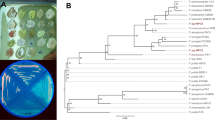Abstract
Two bacterial consortia growing on a random copolymer of ethylene glycol and propylene glycol units were obtained by enrichment cultures from various microbial samples. Six major strains included in both consortia were purified and identified as Sphingomonads, Pseudomonas sp. and Stenotrophomonas maltophilia. Three of them (Sphingobium sp. strain EK-1, Sphingopyxis macrogoltabida strain EY-1, and Pseudomonas sp. strain PE-2) utilized both PEG and polypropylene glycol (PPG) as a sole carbon source. Four PEG-utilizing bacteria had PEG dehydrogenase (PEG-DH) activity, which was induced by PEG. PCR products from DNA of these bacteria generated with primers designed from a PEG-DH gene (AB196775 for S. macrogoltabida strain 103) indicated the presence of a sequence that is the homologous to the PEG-DH gene (99% identity). On the other hand, five PPG-utilizing bacteria had PPG dehydrogenase (PPG-DH) activity, but the activity was constitutive. PCR of a PPG-DH gene was performed using primers designed from a polyvinyl alcohol dehydrogenase (PVA-DH) gene (AB190288 for Sphingomonas sp. strain 113P3) because a PPG-DH gene has not been cloned yet, but both PPG-DH and PVA-DH were active toward PPG and PVA (Mamoto et al. 2006). PCR products of the five strains did not have similarity to each other or to oxidoreductases including PVA-DH.


Similar content being viewed by others
References
Cox DP (1978) The biodegradation of polyethylene glycols. In: Perlman D (ed) Advances in applied microbiology, vol 23. Academic, New York, pp 173–194
Fincher EL, Payne WJ (1962) Bacterial utilization of ether glycols. Appl Microbiol 10:542–547
Harris JM (1992) Chapter 1. Introduction to biotechnical and biomedical applications of poly(ethylene glycol). In: Harris JM (ed) Poly(ethylene glycol) chemistry. Plenum, New York, pp 1–14
Kane MD, Poulsen LK, Stahl DA (1993) Monitoring the enrichment and isolation of sulfate-reducing bacteria by using oligonucleotide hybridization probes designed from environmentally derived 16S rRNA sequences. Appl Environ Microbiol 59:682–686
Kawai F (1992) Mechanisms of bacterial degradation of polyethers and their copolymers. In: Vert M et al. (eds) Biodegradable polymers and plastics. Royal Society of Chemistry, Cambridge, UK, pp 20–29
Kawai F (2002) Microbial degradation of polyethers. Appl Microbiol Biotechnol 58:30–38
Kawai F, Hanada K, Tani Y, Ogata K (1977) Bacterial degradation of water-insoluble polymer (polypropylene glycol). J Ferment Technol 55:89–96
Kawai F, Kimura T, Tani Y, Yamada H, Kurashi M (1980) Purification and characterization of polyethylene glycol dehydrogenase involved in the bacterial metabolism of polyethylene glycol. Appl Environ Microbiol 40:701–705
Klomklang W, Tani A, Kimbara K, Mamoto R, Ueda T, Shimao M, Kawai F (2005) Biochemical and molecular characterization of a periplasmic hydrolase for oxidized polyvinyl alcohol from Sphingomonas sp. strain 113P3. Microbiology 151:1255–1262
Mamoto RH, Nagai R, Tachibana S, Yasuda M, Tania A, Kimbara K, Kawai F (2006) Cloning and expression of the gene for periplasmic poly(vinyl alcohol) dehydrogenase from Sphingomonas sp. strain 113P3, a novel-type quinohaemoprotein alcohol dehydrogenase. Microbiology 152:1941–1949
Marmur JA (1961) A procedure for the isolation of deoxyribonucleic acid from micro-organisms. J Mol Biol 3:208–218
Murray ERB, Doetsch RN, Robinow CF (1994) Determinative and cytological light microscopy. In: Gerhardt P, Murray ERB, Wood WA, Krieg NR (eds) Methods for general and molecular bacteriology. ASM, Washington, DC, pp 31–32
Rychlowska J, Zgola A, Grzeskowiak T, Lukaszewski Z (2003) Isolation of poly(propylene glycols)s from water for quantitative analysis by reversed-phase liquid chromatography. J Chromatogr A 1021:11–17
Sugimoto M, Tanabe M, Hataya M, Enokibara S, Duine JA, Kawai F (2001) The first step in polyethylene glycol degradation by spingomonads proceeds via a flavoprotein alcohol dehydrogenase containing flavin adenine dinucleotide. J Bacteriol 183:6694–6698
Tachibana S, Kawai F, Yasuda M (2002) Heterogeneity of dehydrogenases of Stenotrophomoas maltophilia showing dye-linked activity with polypropylene glycols. Biosci Biotechnol Biochem 66:737–742
Tachibana S, Kuba N, Kawai F, Duine JA, Yasuda M (2003) Involvement of a quinoprotein (PQQ-containing) alcohol dehydrogenase in the degradation of polypropylene glycols by the bacterium Stenotrophomonas maltophilia. FEMS Microbiol Lett 218:3415–3349
Takeuchi M, Hamana K, Hiraishi A (2001) Proposal of the genus Sphingomonas sensu stricto and three new genera, Sphingobium, Novosphingobiium and Sphingopyxis, on the basis of phylogenetic and chemotaxonomic analyses. Int J Syst Evol Microbiol 51:1405–1417
Thompson JD, Higgins DG, Gibson TJ (1994) CLUSTAL W: improving the sensitivity of progressive multiple sequence alignment through sequence weighting, position-specific gap penalties and weight matrix choice. Nucleic Acids Res 22:4673–4680
Acknowledgments
We are grateful to technical advice of Drs. A. Tani and Xin Liu, Research Institute for Bioresources, Okayama University. This work was financially supported in part by Grant-In-Aid For Scientific Research (C) 14560068 from the Japan Society for the Promotion of Science. We are also grateful to grants to F. Kawai from the Wesco Scientific Promotion Foundation and the Yakumo Foundation for Environmental Science.
Author information
Authors and Affiliations
Corresponding author
Additional information
The paper was edited by a native speaker through American Journal Experts (http://www.journalexperts.com).
Rights and permissions
About this article
Cite this article
Hu, X., Fukutani, A., Liu, X. et al. Isolation of bacteria able to grow on both polyethylene glycol (PEG) and polypropylene glycol (PPG) and their PEG/PPG dehydrogenases. Appl Microbiol Biotechnol 73, 1407–1413 (2007). https://doi.org/10.1007/s00253-006-0616-y
Received:
Revised:
Accepted:
Published:
Issue Date:
DOI: https://doi.org/10.1007/s00253-006-0616-y




